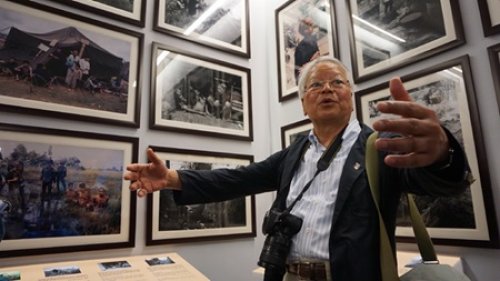Japanese photojournalist recalls memories of war after 40 years
Japanese war photographer Ishikawa Bunyo, 77, who has visited Viet Nam countless times over the last 40 years since the war ended, says his former "battlefield" has seen tremendous development in recent years.
 |
| Japanese photojournalist Ishikawa Bunyo speaks about a photo that he took during the war in Viet Nam at the opening of a permanent exhibition of his wartime photos at the War Remnants Museum on Monday (April 27). - VNS Photo Van Dat |
Ishikawa spoke yesterday at the opening of a permanent exhibition of 107 of his photos, titled 50 Years of Viet Nam – War and Peace exhibition, at HCM City's War Remnants Museum.
Speaking to reporters in halting English as he walked around the room where his photos are displayed, he predicted that 10 years from now, Viet Nam would appear even more different to his eyes than it does today.
"I don't know if I will be able to come to Viet Nam at that time, but I really want to," he said, laughing loudly, adding that his advanced age might prevent a future visit.
The conflict in Viet Nam drew war correspondents from around the world.
As he pointed to his photos on the walls, he recalled how the US administration was not particularly happy about some of the images that its photojournalists were taking, particularly those of civilian deaths.
Ishikawa remembered a similar situation in his birthplace, Okinawa, where civilians were also killed during World War II.
He said that whenever he shot photos of dying soldiers, farmers and children during the war in Viet Nam, he remembered the war in his hometown.
Pointing to a photo of a Vietnamese woman named Tho and her son Cam, he said that their situation was similar to that of his mother during the war in Japan.
Ishikawa was able to meet Tho and her son 25 years later. Cam told him that his father, who fought in the American war, lost one leg and drank a lot, making his mother miserable.
One of his most impressive photos taken during the war in Viet Nam is part of the new permanent exhibition. It depicts a woman carrying a child and running away from her house after it had been destroyed.
The face of the mother, although wounded, shows her concern about the house, as there were still children inside.
The situation was the same, he said, with the war in Japan.
"It is very hard for me to choose the most impressive photo, because all of my photos are my children," he said, pointing to a photo of a military operation conducted in 1986.
"There was a rumour about northern soldiers in a village and I followed them. Napalm bombs were dropped on the village, and then civilians gathered at a certain spot. I could not understand why people attacked civilians," he said.
The photojournalist clearly remembers the story behind every photo.
He said when he returned to his office in Viet Nam to write captions for the photos, he could not get the images out of his head, and when they were published, he still could not forget.
Every time he prepares for an exhibition, he still remembers the old situations.
With these photos, Ishikawa said he wanted to help people to understand the violence of war.
When Ishikawa first set foot in Viet Nam in 1964, he was working as a freelance photographer. He accompanied US and South Vietnamese forces for four years from 1965.
He later worked as a staff photographer for Asahi Shinbun from 1969 to 1984, and then began a career as a freelance photographer. Last year, he marked the 50th anniversary of his first trip to Viet Nam.
The museum yesterday also opened another permanent exhibition of 93 photos by Vietnamese photojournalist Hoang Van Sac, who worked for Viet Nam News Agency during the war, covering the transport situation.
The collection is called Memories of Wartime Roads. "People sacrificed their lives to protect the roads from being destroyed," Sac said.
Source: VNS
















